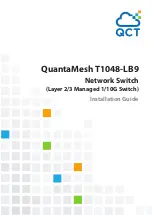
Connecting the RJ-45 Console Port
Procedure
Step 1
Connect the RJ-45-to-DB-9 adapter cable to the 9-pin serial port on the PC. Connect the other end of the cable
to the switch console port.
Step 2
Start the terminal-emulation program on the PC or the terminal. The program, frequently a PC application
such as HyperTerminal or ProcommPlus, makes communication between the switch and your PC or terminal
possible.
Step 3
Configure the baud rate and character format of the PC or terminal to match the console port default
characteristics:
•
9600 baud
•
8 data bits
•
1 stop bit
•
No parity
•
None (flow control)
Step 4
Power on the switch as described in the switch getting started guide.
Step 5
The PC or terminal displays the bootloader sequence. Press
Enter
to display the setup prompt.
Connecting the USB Console Port
Procedure
Step 1
If you are connecting the switch USB console port to a Windows-based PC for the first time, install the USB
driver. See
Installing the Cisco Microsoft Windows USB Device Driver, on page 54
.
Figure 32: Connecting the USB Console Cable to the Switch
Step 2
Connect a USB cable to the PC USB port. Connect the other end of the cable to the switch mini-B
(5-pin-connector) USB console port.
Step 3
Start the terminal-emulation program on the PC or the terminal. The program, frequently a PC application
such as HyperTerminal or ProcommPlus, makes communication between the switch and your PC or terminal
possible.
Step 4
Configure the baud rate and character format of the PC or terminal to match the console port default
characteristics:
•
9600 baud
•
8 data bits
Cisco Catalyst 2960-L Series 24-Port and 48-Port Switch Hardware Installation Guide
53
Configuring the Switch
Accessing the CLI Through the Console Port




































